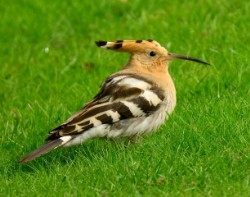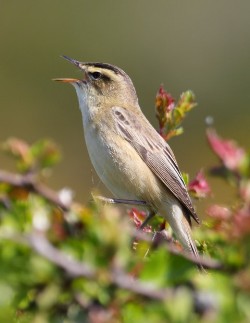April 2020
Bird Sightings



April is the month when spring migration gets underway, with arrivals and departures of birds, all seeking their best breeding territories. This April was very dry with no significant rain for over twenty consecutive days. Like the previous two April there was a lot of easterly winds. The impact on migrating birds of the weather here and throughout their route is difficult to know, but even by the end of the month the bulk of the migrants had still to arrive.
By the end of March, the first Chiffchaff, Wheatear and White Wagtail had been reported. Here are April “firsts” with the 2019 arrival date in brackets for comparison: House Martin 4th(4th), Sand Martin 5th(31 March), Swallow 5th(6th), Willow Warbler 5th(10th), Sandwich Tern 6th(2nd), Common Sandpiper 10th(14th), Cuckoo 14th(19th), Garden Warbler 15th(24 May), Sedge Warbler 16th(20th), Tree Pipit 18th(20th), Grasshopper Warbler 19th(19th), Whinchat 22nd(18th),Whitethroat 23rd(20th) and Manx Shearwater 28th(4th),
In April some of our wintering birds were still around including twenty Whooper Swan at Clachaig on 2nd, two Rook in Sliddery on 5th, nine Redwing in Sliddery on 7th, two Greylag Geese at Cosyden on 17th, four Wigeon at Machriewaterfoot on 18th and four Fieldfare on Corriecravie Moor on 22nd. The last report of Pink-footed Geese was one hundred flying north over Porta Buidhe on migration on 7th.
April is an ideal time for watching migration. These are a few examples: eighty Golden Plover at Machriewaterfoot on 1st, thirty-eight Common Scoter off Cosyden on 8th, five Great Northern Diver off Imachar on 10th, one Bar-tailed Godwit at Cosyden on 23rd, three Dunlin on Blackwaterfoot shore on 24th and twenty Turnstone at Catacol on 26th. In addition, there was a much-reported passage of Sandwich Tern, including nine at Porta Buidhe on 11th, and Whimbrel, including fourteen at Auchenhew Bay on 27th. One Whimbrel which had been ringed on a southern Arran shore three years ago was reported yet again almost on the same shore, for the third year in a row, having again spent the winter in Africa!
Migration was also in evidence from the widespread reports received of Goldfinch and Siskin moving through people's gardens throughout the month. Larger garden numbers reported included ten Siskin in Machrie on 15th and eleven Goldfinch in Lagg on 27th. Tens of thousands of birds seem to be moving through the island at this time of year.
In April there were one hundred and nine species recorded on Arran. Here is a further small selection from this list: seventeen Shelduck at Cosyden on 3rd, eighteen roosting Wren at Sandbraes also on 3rd, one Moorhen and one male Scaup at Mossend Pond on 13th, one Snipe Fisherman’s Walk on 16th, thirty Gannet feeding close in shore in Brodick Bay on 19th, three Goosander at Iorsa mouth on 20th and two Woodcock roding over the Lakin on 21st. The highlight in April was the Hoopoe seen at Levencorrach on 8th. It featured in a recent “Banner” Bird Note.
My thanks to the many people who have been in touch to share their sightings in what has been a remarkable month. As a result of the measures to control the spread of the coronavirus, the island has been in lockdown throughout the month. In this situation, I have appreciated the many people who have continued to make the effort to share their bird sightings with me. I will say more about this in the next Bird Note “Birding in Lockdown”.
From a birding point of view, May should be an equally interesting month with the arrival of more summer visitors including Lesser Whitethroat, Wood Warbler, Swift, Common Tern and, hopefully, even Corncrake and Nightjar.
Finally, spring is a great time to be birding, as most birds are getting on with the business of breeding. The business of breeding involves attracting a mate by song, courtship display and ritual, defining a territory, nest building, and generally establishing relationships. Please take a moment to report any signs of breeding birds to me. Already there have been reports of Blue Tits nest building, Robins feeding young, Blackbirds carrying food, Grey Heron with young in the nest, Dipper carrying food and Song Thrush with young out of the nest.
Please remember that under the Nature Conservation (Scotland) Act 2004 it is an offence to intentionally or recklessly damage or destroy the nest of any wild bird while it is being built or used. Take particular care on our shores and beaches and please keep your dogs on a lead at this time.
Enjoy your birding and keep safe.


